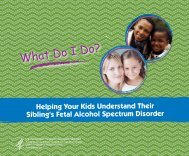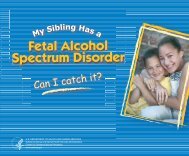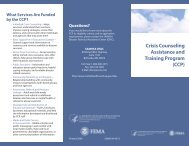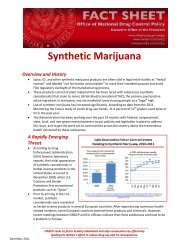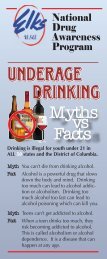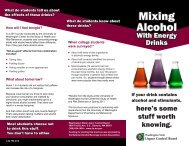Counselor's Manual for Relapse Prevention With Chemically ...
Counselor's Manual for Relapse Prevention With Chemically ...
Counselor's Manual for Relapse Prevention With Chemically ...
You also want an ePaper? Increase the reach of your titles
YUMPU automatically turns print PDFs into web optimized ePapers that Google loves.
There are many models <strong>for</strong> the stages of group development. The following is a composite ofseveral models:Stage 1—PreaffiliationStage 2—Power and controlStage 3—IntimacyStage 4—DifferentiationStage 5—Separation.In the preaffiliation stage, members feel uncom<strong>for</strong>table, anxious, or fearful with the newness ofthe experience. In this stage, members look to the leader <strong>for</strong> direction. Initially, the group shouldbe leader-focused, with the leader helping members adjust to the new experience.Once group members are more com<strong>for</strong>table, it is predictable that they will challenge theauthority of the leader and will pursue power and control. It is important <strong>for</strong> the leader toremember that this is a normal style in the group's development, not unlike the challenges thatface the parents of an adolescent. This phase may be uncom<strong>for</strong>table, with group membersexpressing anger and frustration. The leader should be careful not to personalize these challengesto authority. The leader should be consistent, avoid fighting with the group, and allow the groupto become more autonomous without sacrificing his or her position of authority.In the next stage, some degree of intimacy is established. It is very important <strong>for</strong> the leader tomove members to a common level of intimacy be<strong>for</strong>e allowing too much self-disclosure by thegroup members. The setting and type of the group will determine the overall level of intimacy.As members feel safer in the group, they can better engage in activities and take risks necessary<strong>for</strong> change. At this stage, the leader can give less direction, allowing the members to worktogether more spontaneously and more independently.Differentiation is the stage at which members have a strong sense of identification with the groupand feel trusting. This is the most productive stage of group development.Finally, at the point of termination or separation, members experience a range of feelings anddisplay a range of behaviors in anticipation of leaving the group. It is important to remember thatchemically dependent people typically have experienced a lot of loss over their lifetimes. Manyhave lost family members and friends to violence and illness. They do not handle the ending ofrelationships well. Termination of the group or loss of a group member presents an importantopportunity to deal with this problem. The leader should begin to prepare the group <strong>for</strong> endingwell in advance and do so gradually. The leader can expect members to use denial or to regress.It is important to predict these behaviors and to identify them as they occur.These stages of group development are very predictable. Virtually all groups go through them.However, depending upon the circumstances a group may regress to an earlier stage at any time.For example, if a group adds new members, the level of intimacy will decrease. The group mayreturn to a stage of preaffiliation. It is hard to predict how long a group will stay in a particularstage of development. The type of group (i.e., mandatory or voluntary), the setting (i.e.






